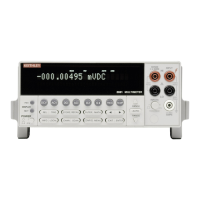Front Panel Operation
3-71
For this example, the Models 2001 and 7001 are configured
as follows:
Model 2001:
Idle state:
Bench reset = :INIT:CONT ON*
Arm layer:
Arm source = Immediate*
Arm count = 1*
Arm trigger control = Acceptor*
Scan layer:
Scan source = Immediate*
Scan count = Infinite*
Scan trigger control = Acceptor*
Measure layer:
Measure source = TrigLink
Trigger link mode = Asynchronous*
Input line = #2*
Output line = #1*
Measure count = 10
Measure trigger control = Acceptor*
* Indicates that the setting is the BENCH RESET (and factory) default con-
dition.
Model 7001:
Idle state:
Reset = :INIT:CONT OFF*
Scan list = 1!1-1!10,
Arm layer:
Arm spacing = Immediate*
Arm count = 1*
Arm trigger control = Acceptor*
Scan layer:
Scan spacing = Immediate*
Number of scans = 1
Scan trigger control = Acceptor*
Channel Layer:
Channel spacing = TrigLink
Trigger link mode = Asynchronous*
Input line = #1*
Output line = #2*
Number of channels = Use Scanlist length*
Channel trigger control = Source*
* Indicates that the setting is the RESET (and factory) default condition.
Notice that the Model 2001 is reset to BENCH defaults. With
this selection, the multimeter stays armed. Since the arm
source and scan source are set to Immediate, the Model 2001
waits in the measure layer for a trigger.
With the Channel Trigger Control of the Model 7001 set for
Source, scan operation initially bypasses the need for a Trig-
ger Link trigger to close the first channel. Since arm spacing
and scan spacing are set to Immediate, the scan starts as soon
as the scanner is taken out of the idle state by pressing the
STEP key.
To run the test and store the readings in the Model 2001,
press STORE on the multimeter, enter the desired number of
readings (ten), and press ENTER. The Model 2001 waits
(with the asterisk annunciator lit) for a Trigger Link trigger
from the Model 7001.
Press STEP on the Model 7001 to start the scan. The scan-
ner’s output pulse triggers the Model 2001 to take a reading,
store it, and send a trigger pulse. The following explanation
on operation is referenced to the operation model shown in
Figure 3-31.

